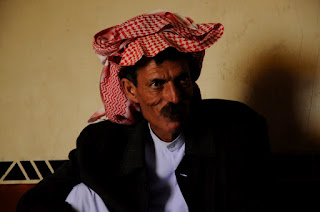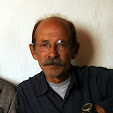But for Sinjar Mountain there is no topographic relief in the region of northwestern Iraq or northeastern Syria. The 75 kilometer-long mountain runs on an east-west axis; its narrow ridge seems lonely.. Its history is as radical as itself, and has been home to Yezidian people as long as can be remembered.
Today the Yezidis are still there, but the world has changed. In the 1980s Saddam Hussein, in the time-honored strategies of despotic rulers, sought to lessen the threats of enemies (real or perceived) through ethnic dilution. In this case he moved Kurdish and Arab Muslims into the Sinjar region. Additionally, he forcibly relocated the Yezidis from their villages to desolate concrete collective villages (mujamabaats) on the plains at the foot of both the north and south sides of the mountain.
Tentatively a few Yezidis are moving back to some of the villages. But all sense danger and realize neglect. The Sinjar is not officially in quasi-independant Iraqi Kurdistan where conditions of safety for the Yezidis, although not perfect, are relatively secure. Additionally the Sinjar is a poor brother to Iraqi Kurdistan when it comes to the sharing of the Kurdistan Regional Government's largess.
The comforts of modernity erode tradition. There are few such comforts in the Sinjar.
These are portraits of Sinjari Yezidis – primarily sheikhs and faqirs - both religious designations within Yezidi'ism. The younger and more educated generation prefers Western-styled clothes; and, mustaches, if at all, are modest, as is the dress for all women.















Are you hearing many opinions from the Yezidis about the recent political instability in Syria or is that outside of what they consider relative to their lifestyle?
ReplyDeleteThere are Yezidis people in Armenia who live in a seemingly safe although very rural area of the country. As I recall from earlier readings of Armenian news, Yezidis are involved politically.
ReplyDeletewe do have Yezidis people I'm Yezidi and there is like 500 yezidis people live in Lincoln Nebraska
ReplyDeletethey are in everywhere.
Thanks for your note, Fadhil. With great pleasure in 2008 I visited your Yezidi community in Lincoln. And you are right, Yezidi communities are found in many countries.
DeleteYou welcome bro. Yezidi people they are in everywhere.
ReplyDeleteFrom the readings in the Book of Job it seems to me that that Prophet Job might be an ancestor of these Yazidi tribes. May be this assumption needs further investigation. May I request the google specialists to elucidate on the subject.
ReplyDeleteThanks & Regards
Lovely blog, thanks for taking the time to share this.
ReplyDelete